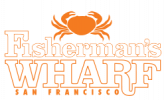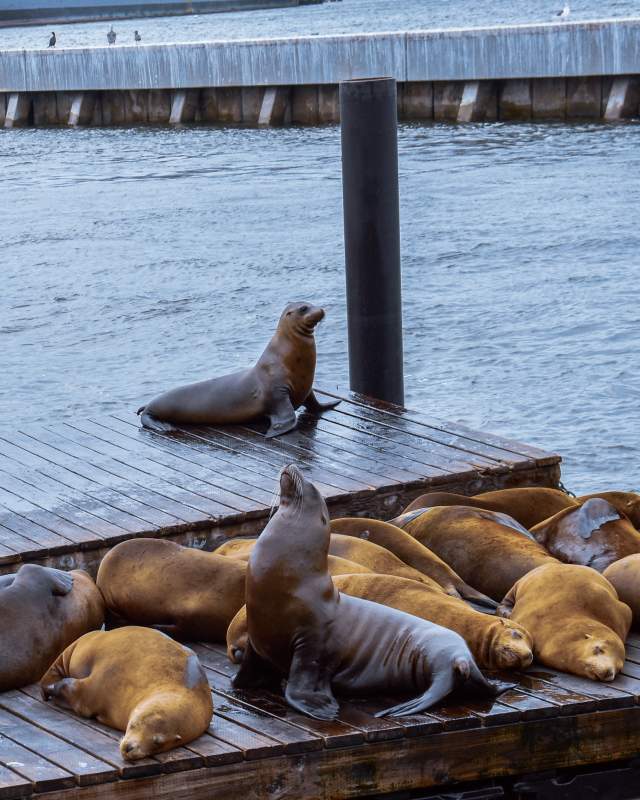Fisherman's Wharf Sea Lions
Meet World-Famous Sea-Lebrities in San Francisco
Looking for the Wharf’s loudest, laziest, and most lovable locals?
If so, it’s time to head to the docks and check out one of the Wharf’s wildest and most popular attractions—the sea lions!
Barking and basking, these whiskered wonders have been stealing the show at the Wharf for decades, lounging around and delighting anyone who stops by to see them.
Discover more about these delightful creatures in our:
Sea Lions at the Wharf: FAQs
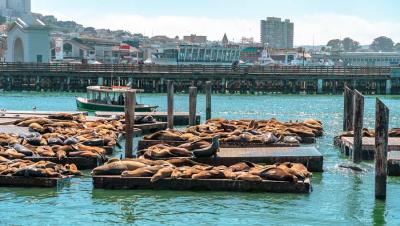 Looking for fun, FREE things to do at Fisherman’s Wharf?
Looking for fun, FREE things to do at Fisherman’s Wharf?
Trying to find more family friendly activities?
The sea lions at Fisherman’s Wharf are all that and so much more, enchanting visitors of all ages with their attention-grabbing antics.
Come and enjoy them in person, alone, on a date, or with any group.
When you do, get ready to be charmed—and here’s some info to help you enjoy it all to the absolute fullest.
-
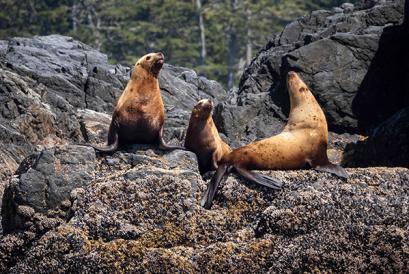 You’ll find San Francisco’s most famous flippered celebrities lounging in style at PIER 39 in Fisherman’s Wharf.
You’ll find San Francisco’s most famous flippered celebrities lounging in style at PIER 39 in Fisherman’s Wharf. Sun-loving and social, the sea lions at PIER 39 have been a crowd-favorite at the Wharf for decades.
They love hanging out on the floating wooden docks on the West Marina, just steps from shops, seafood, and some of the most beloved attractions in San Francisco.
Here are a couple of things to keep in mind about the sea lions at PIER 39:
- The number of sea lions changes with the seasons, but some stick around year-round, especially the big, bossy males.
- Head to the Sea Lion Center for some of the best views and loudest barks.
-
Yes! Sea lions are wild animals, so their numbers can change with the seasons.
Still, at different times of the year, you can see dozens to hundreds of sea lions at PIER 39.
-
Always—PIER 39 is home base for some sea lions year-round. Several more stop by during specific seasons.
The table below highlights the peak vs. the off-season for sea lions at PIER 39.
When to See Sea Lions Time Why? Peak season
March to May; and August to OctoberFood is plentiful, and conditions are ideal. Off season
June and JulyMany head south to the Channel Islands to breed. With the comings and goings of the PIER 39 sea lions:
- Adult males make up the lion’s share of the seasonal visitors, traveling in the summer and returning to chill (and squabble) on the docks from fall through winter.
- Big crowds of sea lions can be noisy and smelly! In 2024, on Father's Day weekend, there was a surge in sea lion numbers at San Francisco's PIER 39, with counts reaching over 1,000 and even up to 2,000 at one point, which is the most seen in over 15 years.
- The off-season can offer a low-key, more sensory-friendly experience for anyone with diverse sensory needs.
🦭💡Pro Tip: Check the Sea Lion Live Cam before you go or whenever you want to see them in action!
- Adult males make up the lion’s share of the seasonal visitors, traveling in the summer and returning to chill (and squabble) on the docks from fall through winter.
-
The sea lions at the Wharf are living their best life on the floating wooden docks at the West Marina at PIER 39, right next to the Bay. Some have made K dock their permanent home.
To find the sea lions at PIER 39:
- Head to the left side of the pier when facing the water.
- Look for the Sea Lion Center.
- Listen up—you’ll probably hear the sea lions barking before you see them.
- Get ready for FUN and get your camera ready to take some ama-sea-ing photos!
Whether they’re barking, sunbathing, snoozing in a pile, or squabbling on the dock, the sea lions at PIER 39 always know how to make a splash. And it’s 100% FREE to stop by and watch them whenever you want.
That’s why they’re one of the most iconic wildlife shows in the City.
-
Many people ask why the sea lions are at PIER 39, and the answer is simple—they love it here!
That’s because PIER 39 gives sea lions:
- Plenty of space to lounge, sunbathe, and snooze on the docks
- Safety from predators, with no natural threats nearby
- A rich supply of food in the Bay’s waters
The PIER 39 sea lions have been around for decades, first flocking here in large numbers after the 1989 Loma Prieta earthquake. That’s when they started “moving in” to empty boat docks.
By early 1990, they’d taken over the place. The PIER 39 staff welcomed these new neighbors and have let them hang around “rent free” ever since!
-
If you want front-row seats to the sea lion spectacle, timing is everything!
That’s because these whiskered creatures can be super active and playful at certain times of the day—and more inactive during others.
So, if you’re trying to time your sea lion visit just right, here’s what they’re usually doing from sunrise to sunset and after.
Best Times to See Sea Lions at the Wharf Time of Day Why? Morning
9 a.m. to 11 a.m.Great time to stop by, with fantastic lighting, cooler weather, and active sea lions! Midday
Noon to ~2 p.m.Hit or miss—sometimes they nap, and sometimes they party. Late afternoon
~3 p.m. to 5 p.m.Another great time to stop by, with golden hour views and that perfect sea lion glow! Nighttime
After ~5 p.m.Not ideal—sea lions are diurnal (i.e., active during the day), so there’s not much activity at night. Remember, you’ll have the best chances of seeing sea lions in action when:
- The sun’s out, and the docks are warm.
- You stop by during the morning and late afternoon.
-
Nope—there are no tusks here! While sea lions have made themselves right at home at the Wharf’s PIER 39 in San Francisco, walruses don’t live along the California coast.
To see a walrus in the wild, you’ll need to be in an icy, Arctic area. That’s where these large mammals live, chilling on sea ice and snacking on clams.
Here are a few differences between walruses, sea lions, and seals:
- Walruses are big, blubbery creatures, with long tusks and a love for cold climates.
- Sea lions are sleek and “talkative,” commonly barking and right at home on the sunny docks of PIER 39.
- Seals are smaller and quieter than sea lions.
So, while you won’t spot any walruses at Fisherman’s Wharf, the sea lions here more than make up for it in personality and volume!
-
Craving seafood and a sea lion show?
If so, you’re in luck at Fisherman’s Wharf, where you can feast on the freshest seafood, stunning Bay views, and endlessly delightful sea lions at play.
Some of the best restaurants to grab a bite and watch the sea lions are:
-
Fog Harbor Fish House: Upstairs at PIER 39, Fog Harbor Fish House is a San Francisco landmark that has sweeping views of the sea lions and the Golden Gate. It’s also been named one of the Top 5 Best Restaurants in SF.
-
Pier Market Seafood Restaurant: As another great spot to watch sea lions at the Wharf, Pier Market Seafood Restaurant has a lovely selection of grilled seafood, with indoor and outdoor seating along the waterfront.
-
Wipeout Bar & Grill: Offering casual entrees in a surf-themed setting, Wipeout Bar & Grill can be a more relaxed, low-key spot to take in the sea lions while grabbing a bite.
-
Swiss Louis Italian & Seafood Restaurant: A Fisherman’s Wharf favorite since 1936, Swiss Louis serves up classic Italian dishes alongside fresh-from-the-Bay seafood with unbeatable waterfront views.
-
Crab House at PIER 39: Crab House is known for its famous “Killer Crab®”—a sizzling Dungeness crab roasted in a secret garlic sauce and served with a view of the San Francisco Bay.
Many restaurants where you can watch the sea lions accept both walk-ins and reservations. So, you can book a table ahead of time for guaranteed seating, or you can make plans on the fly.
-
General Sea Lions FAQs
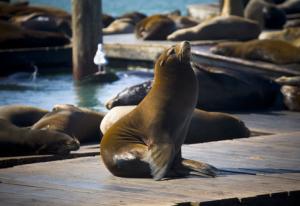 Got questions about sea lions in general?
Got questions about sea lions in general?
If so, we’ve got you covered—with no wetsuit required!
Here’s where we break down some wild, wonderful facts about sea lions, answering common questions about them.
So, get ready to dive into the world of the sea lions! 🦭
-
No—Sea lions and seals are similar, but they are not the same animals (i.e., they are different species).
Though both are flippered (and fabulous!), they have distinct anatomies and totally different personalities. The table below highlights a few ways to tell sea lions apart from seals.
Sea Lions vs. Seals Characteristic Sea Lions Seals Size (Average Male) Larger
Up to ~800 pounds,
8 feet longSmaller
Up to ~300 pounds,
6 feet longEars External ear flaps No visible ears Movement on land “Walk” using front flippers Wiggle, like a fuzzy sausage Personality Super vocal, love to bark, highly social Quieter, more solitary Think of sea lions and seals as ocean “cousins”—they’re related and similar in some ways but, still, completely different.
-
Sea lions are marine mammals classified as pinnipeds, a group that also includes seals and walruses.
Six species of sea lions live in different parts of the world, including the:
- California sea lion, native to the western coast of North America, from Alaska to central Mexico
- Steller sea lion, the largest of all sea lions, found in the North Pacific, from Japan to California
- South American sea lion, found along the coasts of South America, including Argentina, Chile, Peru, and Uruguay
- Australian sea lion, native to the southern and western coasts of Australia
- New Zealand sea lion (or “Hooker's sea lion”), primarily found around New Zealand's subantarctic islands
- Galápagos sea lion, native to the Galápagos Islands and a few areas along the Ecuadorian coast.
Each species has adapted to its unique environment, with differences in size, coloration, and behavior.
At PIER 39, you’ll see California sea lions. Highly intelligent and readily trainable, California sea lions are:
- Super social and playful
- Covered in short, thick fur
- Known for their classic “arf! arf!” barks
- Round, with big, blubber-filled chests and bellies
- Able to rotate their hind and fore flippers to "walk" (not roll) on dry land
- Excellent swimmers and divers, zipping through the water with surprising speed
California sea lions are also usually the ones that are trained to do tricks for treats at zoos and amusement parks.
That’s because they’re fun, acrobatic, and 100% entertaining!
-
Sea lions love life by the ocean, from sunny beaches to docks, buoys, and rocky shores.
Depending on the species, sea lions can be found in waterfront areas all around the world, including (and not limited to):
- South America
- New Zealand
- Australia
- North Pacific
If we’re talking about the sea lions at PIER 39, we’re talking about California sea lions. These are true locals who also tend to move around, hanging out:
- Along the Pacific coast, from California to Mexico
- As far north as Oregon or British Columbia
In San Francisco, the sea lions love PIER 39, especially in the cooler months when safety, space, and food are plentiful.
-
As cute and quirky as sea lions are, they’re still wild animals.
So, yes, they can be dangerous if you get too close or invade their space. Plus:
- Sea lions are strong, fast, and not shy.
- They have sharp teeth and powerful jaws (don’t let their sleepy look fool you).
- If sea lions feel cornered or threatened, they may lunge, snap, or bark loudly to warn you off.
None of this means that you can’t safely enjoy the PIER 39 sea lions, though! After all, they’re NOT trying to be aggressive, and they’re not looking for a fight.
So, just keep these simple tips in mind for safe sea lion visits at the Wharf:
- Enjoy the sea lions from a safe distance, like the designated viewing areas at PIER 39.
- Never attempt to feed, pet, or approach sea lions. It’s unsafe and illegal.
At a bit of distance, the Wharf sea lions are completely safe, wildly entertaining, and endlessly fun to watch!
-
With all their barking, playing, and lounging about, the PIER 39 sea lions are certainly charming—and they seem very friendly.
That personality does not mean they’re automatically friendly with humans. Instead:
- Sea lions are wild and undomesticated.
- They are friendly with their own kind, especially in big groups.
- They’re curious and may approach boats or swimmers—but that doesn’t mean they want to hang out or make friends.
Remember:
- Getting too close to sea lions can stress them out or make them defensive.
- Sea lions are best enjoyed from a safe, respectful distance, like the viewing decks at PIER 39.
-
Sea lions love seafood!
As skilled hunters, sea lions can dive, twist, and chase down their meals in the open ocean, often snacking on whatever’s swimming nearby.
That could include sea lion favorites, like:
-
Squid and octopi
-
Crabs and other small marine creatures
-
Herring, anchovies, sardines, salmon, and other fish
Depending on their size, sea lions can eat between 15 and 35 pounds of food per day.
So, next time you’re enjoying crab or other seafood at the Wharf, you and the sea lions could be dining on very similar feasts (almost side by side)!
-
-
Sea lion weight depends on gender and age (and other factors). That said, adult sea lions tend to weigh hundreds of pounds, with males being substantially larger and heavier than females.
The table below breaks down average weight for California sea lions in pounds (lbs.), based on age and gender.
California Sea Lion Category Min. Average Weight Max. Average Weight Adult males 600 lbs. 1,000 lbs. Adult females 200 lbs. 250 lbs. Pups (at birth) 13 lbs. 48 lbs.
Sea lions can get pretty hefty, with a whole lot of muscle and blubber to keep them warm—and power their surprising agility—in chilly ocean waters. -
A long time—sea lions can hold their breath underwater anywhere from ~3 to 20 minutes.
With slow heart rates and bodies built for diving, sea lions tend to hold their breath for:
- 5 to 10 minutes during normal, “shallower” dives (less than 100 feet)
- Longer and up to ~20 minutes in deeper dives or escape mode.
-
In the wild, sea lions can have varying lifespans, based on food supply, predators, and other factors.
Generally, many California sea lions enjoy years of fun, with average lifespans for males versus females shown below.
California Sea Lion Category Min. Average Age Max. Average Age Adult males 15 yrs. 20 yrs. Adult females 25 yrs. 30 yrs. In captivity, with steady meals and no predators, sea lions can live even longer.
-
Arf, arf, arf—that classic sea lion bark is how sea lions communicate, and oh boy, do they have a lot to say!
Talkative and social, sea lions may bark to:
- Claim territory on the dock: This is especially true during peak lounging hours or the peak season, when hundreds of sea lions are at PIER 39.
- Warn “rivals”: Barking can be defensive, alerting a possible threat before more aggressive actions are taken, like biting.
- Call to others: Sea lions may bark to contact their pups or communicate with other adults in their group
- Get attention: Sometimes, sea lions bark simply to show off their vocal cords and get their moment in the spotlight!
So, while it might sound chaotic, sea lion barking is really just chatter, and you’ll hear plenty of it at PIER 39!
-
No. Barking, playing, and more can make sea lions seem very similar to dogs, but they are two totally different species.
In fact, even though sea lions and dogs are whiskered, playful, carnivorous mammals:
- Sea lions are classified as pinnipeds, like seals and walruses.
- Dogs are classified as canids, like wolves and foxes.
So, there’s no genetic connection between sea lions and dogs, and they’re not technically related.
Still, if we had to name any sea creature that’s most like dogs, sea lions would be our first choice!
Ready to plan your next trip to the Wharf?
explore more attractions
Alcatraz
No trip to San Francisco’s Fisherman’s Wharf is complete without a trip to Alcatraz…
SkyStar Wheel
You’ll leave your heart in San Francisco after a ride on the City’s first waterfront…
Things To Do With Kids
Fisherman's Wharf is the most family-oriented place in San Francisco and contains the highest…
